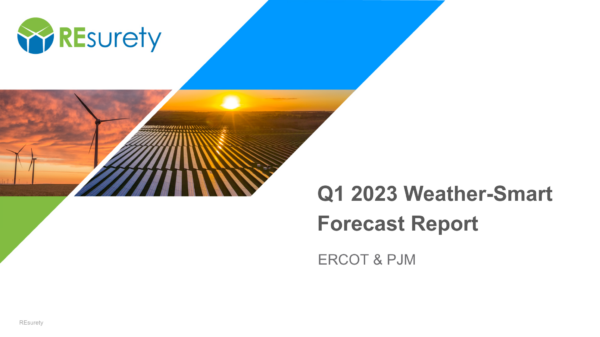May 4, 2023

In late 2022, we announced the availability of Weather-Smart fundamentals power price forecasts. These forecasts give our customers unprecedented insight into the connection between weather, fundamentals, and value. Using REsurety’s suite of products and services, customers can determine the value of clean energy projects under expected conditions, stress test downside risk, and quantify potential upside. They can assemble and monitor portfolios of assets that help mitigate correlated risks. And they can quantify the carbon impact of clean generation, storage, and power consumption, accounting for location, timing, and a changing grid.
We recently updated our Weather-Smart forecasts for ERCOT and PJM. These forecasts are now available across REsurety’s offerings. Accompanying this release, our customers have also received our new report. This report provides customers with increased visibility into the methodology and input data driving our forecasts, giving them what they need to make better decisions using our forecast data. The report also provides a summary of high-level takeaways and discusses the changes in our outlook since the previous release.

Our Q1 2023 Weather-Smart forecasts provide forward-looking views of Around the Clock (ATC) power prices, market heat rates, wind and solar capture rates, and Locational Marginal Emissions rates (LMEs) for a selection of hubs in ERCOT and PJM. Forecasts include five fundamental scenarios and represent 40 years of weather variability. Some of our high-level takeaways include:
- Solar Buildout Drives Capture Rate Shifts: Our modeling consistently shows substantial reductions in solar capture rates as solar buildout ramps up. The speed of the decrease depends on fundamentals, weather, and market. But our results show it is unlikely for solar to retain greater than 100% capture rates for very long.
- Weather and Fundamentals Drive Meaningful Capture Rate Variability: Capture rates (calculated with ISO-average generation) vary by approximately 60 percentage points for solar and approximately 30 percentage points for wind for some markets and forward years. Even larger ranges of capture rates are expected when considering site-specific generation profiles.
- Gas Prices Are Down: Since our Q4 2022 release, gas forwards dropped by more than $4/MMBTU in the near term and about $1-$2 across the forecast horizon. This change reduced near-term ATC power prices, increased market heat rates, and reduced wind and solar capture rates.
- Demand Up in ERCOT: ERCOT revised up its peak demand forecast by 3-6 GW across the forecast horizon, reflecting growth in LNG, oil and gas exploration, and chemical industry demand. This change contributed to an overall tightening of the supply/demand balance in ERCOT, resulting in higher ATC prices, lower wind and solar capture rates, and more weather-driven volatility.
- ERCOT Near-Term Solar Installations Increased: Mostly due to 2022 realized additions exceeding expectations, baseline solar capacity by 2025 is about 5 GW higher than our previous release. This increase contributed to increased wind capture rates and reduced solar capture rates in the near term.
- Congestion Tightened: Model refinements led to increased hub-to-hub congestion in ERCOT, with near-term forecasted values consistent with recent observations. On a 10-year forecasted average basis, Houston Hub ATC prices now exceed Panhandle Hub by about $9/MWh.
If you are a forecast customer of REsurety, this report is included in your service. If you’re interested in learning more about REsurety, this report, and other products and services, please reach out to [email protected].
About the author
David Luke Oates leads REsurety’s Power Markets Research team. His team builds, tests, and deploys fundamentals and statistical models of electricity prices and emissions to support customer workflows. David Luke has over a decade of experience working in the electric power sector from positions in academia, consulting, and technology. Before joining REsurety, he was a consultant at The Brattle Group, supporting electricity market operators, utilities, and asset owners to address market design, asset valuation, and regulatory questions.
Dr. Oates holds a Ph.D. in Engineering and Public Policy from Carnegie Mellon University and a Bachelor’s degree in Engineering Physics from Queen’s University, Canada.

